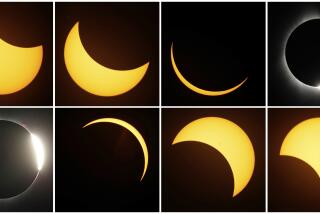Tail-wiggling comet Lovejoy grazes Sun to reveal solar mysteries
The comet Lovejoy plunged into the sun’s blazing corona in 2011 and somehow made it out “alive.” That’s a feat that no man-made spacecraft could have achieved. Now, in a paper published in Science, astronomers show how they tracked the hurtling ice ball’s path as it grazed the sun to learn more about the solar magnetic field.
Lovejoy, known more officially as C/2011 W3, came within a mere 87,000 miles of the sun’s surface as it flew by on Dec. 15 and 16, 2011. NASA’s Solar Probe Plus, planned for launch in 2018, will come within about 3.7 million miles of the sun’s surface – more than 40 times as distant as Lovejoy’s encounter. Keep in mind that for a spacecraft, plunging even that close to the sun is a feat, given that the electronics have to withstand the fearsome heat.
Because Lovejoy’s path took it within – astronomically speaking – spitting distance of the sun’s surface, the scientists decided to use the comet as “a naturally occurring celestial explorer.” Its footprints through the corona – the sun’s ghostly atmosphere, which somehow heats up to millions of degrees Fahrenheit – would help scientists probe closer to the sun’s surface than humans have ever been able to do.
When a comet passes so close to the sun, material from its surface starts to evaporate, trailing out behind it in a tail that’s bright enough to see. Using NASA’s Solar Dynamics Observatory and its twin STEREO spacecraft, scientists watched the comet’s tail as it flitted through the sun’s atmosphere and then fed these data from multiple perspectives into a computer to create a magnetohydrodynamic model of the sun’s atmosphere.
They found that “wiggles” in the tail might suggest that charged ions in the tail were somehow interacting with the local magnetic field in intricate ways.
“This bolsters the exciting prospect that coronal observations of comet flybys can offer a unique and complementary avenue toward understanding the solar atmosphere,” the authors wrote.
Though it will take further study to figure out what exactly is going on, scientists are in luck, the authors pointed out: More cometary close encounters are coming up this decade.
Follow me on Twitter @aminawrite.







